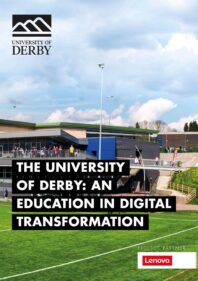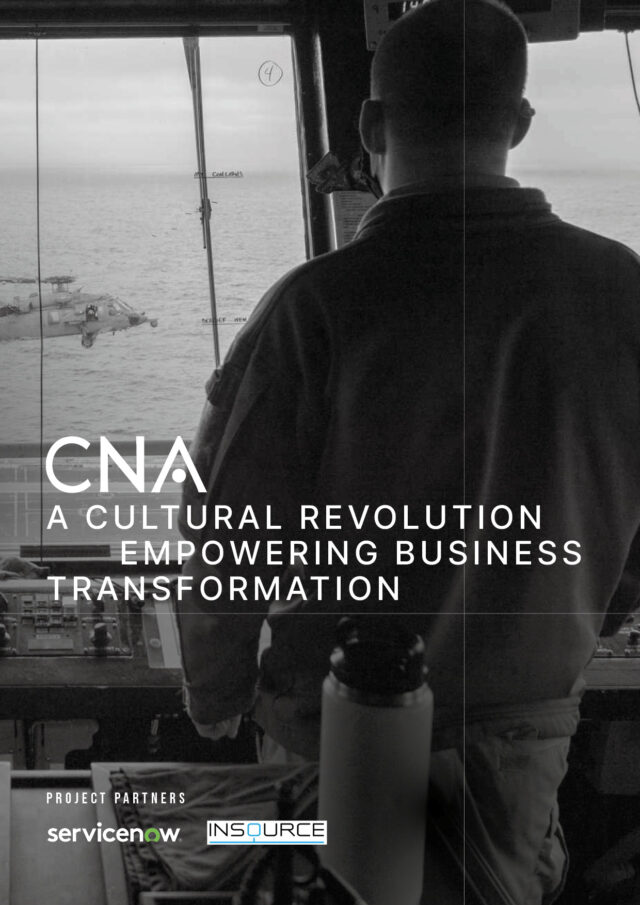We caught up with Neil Williams, Director of IT and Digital Transformation at the University of Derby to see how a massive digital transformation is enriching every element of this forward-thinking educational establishment…
These are highly disruptive times in higher education, just as enterprises in many sectors battle it out for points of differentiation while struggling to remove barriers to entry in providing a seamless, 24/7 customer journey. Add to that an increased customer expectation related to a rise in tuition fees and UK universities face a challenging proposition as competition intensifies. Higher educational establishments must be agile in their processes and behaviour to stand any chance of attracting, retaining and successfully teaching the right kind of students whilst also diversifying their income streams and supporting UK growth with business partners, through research and knowledge exchange.
Neil Williams joined the University of Derby, and its 20,781 students, in 2006 and has spent the past 13 years transforming its technological infrastructure and digital strategy. The university’s motto is Experientia docet, which translates as ‘Experience is the best teacher’ and Williams is nothing, if not a highly experienced tech leader, having worked on the product side of software and tech in industry prior to joining. Williams is more than acutely aware of his role in empowering the university to face, head on, its numerous challenges.
“In the UK, we’ve got a lot of policy changes, for example, as the landscape rapidly changes; and that’s a real challenge for us,” he explains. “However, I think the challenge here comes back to partnerships with a wide range of internal and external stakeholders. The business is working immensely hard on trying to respond to all of these different changes and implications and it sometimes finds it hard to create the capacity to work with us, although a partnership is actually critical to help us to deliver on what the institution needs.”
It is very, very easy to spend vast amounts of money on new software, architecture and systems, but for a digital transformation to be successful, it has to align with the business. “The main thing around achieving digital transformation is business engagement,” Williams explains. “And of course, there are financial implications and challenges that the business has to understand. When it says, ‘We need to be more digital,’ does it understand what that’s going to cost? And therefore, how do you forecast and plan and help the business understand what it’s getting into in terms of these costs especially with modern, subscription-based cloud products? As IT, we’ve got to get better at forecasting those financial implications over the next three to five years because we are now on a ‘pay as you use model’ which needs to be managed.”
When Williams joined the university in 2006 there was no defined strategy with regards to IT and so a plan was formulated and successfully signed off, rewarding Williams and his team with five years of funding for future projects, thus opening up longer-term initiatives. “That was quite a major breakthrough for us,” says Williams. “That particular strategy was primarily about building a reliable and resilient infrastructure, so it was about networks, servers and data centres. We built a second data centre and put in resilient fibre optic cables between several key sites; it was all the things to do with resilience and reliability. We went heavily virtualised at that time as well which helped to support resilience but also flexibility and speed of deployment.”
“The focus of that first IT strategy was to get the core infrastructure to a high enough quality for the university to operate on and trust especially given our significant growth in online education. At the same time, there was a focus on building and improving the customer service ethic within the IT department. This is what I love about my role at the University of Derby,” Williams enthuses. “I’m a service provider trying to help people deliver better service to students to achieve better outcomes and high-quality services to business that can create growth and innovation. That first strategy was about resilience and reliability, but also about improving customer service and valuing our customers more and becoming more customer friendly, more understanding of the issues they have. Our customer service feedback has shown us to be in the high 90%s for over ten years now and this remains a key measure of our service.”
In 2013, a second five-year IT strategic plan was put in place building on the work delivered in the previous five years. Williams and his team started to construct a much more externally focused engagement around the IT organisation at the university. “The infrastructure had got to be much better, so in 2012/2013 we started to develop a second IT strategy to look at another five years. That was very similar, but started to move much more into efficiency and the effectiveness of process and data across the organisation and gaps in our digital provision. We started to focus more on compliance and risk-management, business efficiency and agility, and the business value and effectiveness.”
Partnerships are key
Partnerships are essential to any successful digital transformation and the University of Derby has been careful to select the right strategic partners who contribute to the relationship and bring market intelligence and insight. When Williams started work on replacing the university’s entire network with a modern technology to improve performance, reliability and security, he called upon Cisco. “Cisco were supportive and helped us on that journey and now we’ve got this fantastic new hardware infrastructure in place,” says Williams. “We have an intention to make it much more software defined, to maximise the investment we have made and the new capabilities now available to us. Cisco and Logicalis are both helping us on our journey and whilst it is still an ongoing programme of work, I am excited about the potential as we achieve our aim of an increasing flexible and agile infrastructure.”
Agility is key to successfully transforming any enterprise, particularly in higher education. “We’ve got this big estate, this big network, but we don’t know necessarily who’s going to be on the end of it and why and because the university partners with lots of third-party organisations, we have to be quite agile and flexible to support our Institution. Quality is clearly also important to us given the size of the IT estate we operate and we need reliability of products so we can focus on transformation not operational issues. The use of high-quality products from partners like Lenovo is very important to us in achieving our strategic ambitions.”
The digital strategy
In 2014, the Vice Chancellor at the time asked Williams to do a more focused piece of work on some key lines of digital. “I created a supplementary strategy which focused on business intelligence, supporting income generation, improving planning and academic service,” he explains. Rather than lumping every operation into an IT space, a clear demarcation was formed between IT and digital. An IT strategy is about infrastructure service, PCs, cyber security, which differs from a digital strategy, which is more about business, value, efficiency, effectiveness and the customer. The digital strategy is currently focused on recruitment and conversion, digital learning, apprenticeships, business engagement, compliance, planning and decision support, research support and resource utilisation, which means workforce utilisation but also estate utilisation, communication and collaboration, learning spaces and staff productivity.”
It’s one thing to have the capability and agility to push a business forward but if your staff are not onboard, it’s next to useless. “We may end up delivering this digital capability, but it’s not being exploited by the business because they haven’t got the time or the resources or the skills to use it.” To counter this, Williams set up a pioneering adoption team. “What we’re trying to do with the workforce within IT services now, particularly as we go more to cloud, is focus more on helping people to adopt and maximise technology. I think we can do more of that now because quite a lot of our services are moving into the cloud naturally because our suppliers are increasingly cloud-based,” Williams explains. “It’s now about business engagement, business understanding, and business time, and understanding that just because we have put a new system in place our colleagues haven’t necessarily got the time to engage and understand how to exploit the delivered capabilities. A good example of this is Office 365. We’ve had Office 365 for a while, it’s got fantastic capability in it, particularly some of the capabilities around Teams and how people can interact and collaborate. But lots of people just don’t find the time to go and play with it and feel comfortable with the features. My adoption team has been spending most of its time working with Microsoft and with other people in my organisation delivering roadshows, videos and various communications on Office 365 adoption. Once we get people on it, they won’t come off it, because it’s brilliant. However, this is just the start, I need to also help colleagues more to engage with our new Microsoft CRM, our new Oracle Finance system and our new iTrent HR system as well as a myriad of other new capabilities we are establishing.”
“As an IT Department we also make a significant contribution to our regional community and regional partners. An example of this is our partnership with our schools liaison team where we are helping with careers advice in schools. This is our department engaging with the wider university in its civic role where we can hopefully add value to local communities and future generations. Specifically, we are trying to help encourage young people into technology careers as there are so many opportunities and different career paths. We are also doing promotion work in schools encouraging women in IT to try and get a more diverse community interest in technology careers. We also run a work experience programme for local schools and have had over 30 local school children come and spend a week with us where they meet all of our teams – I personally spend two hours with each placement helping them understand the industry, the roles and the opportunities.”
The new oil
Universities amass a lot of precious data and being able to use those insights across the entire business requires an end to the siloed approach that can be a limiting factor in many universities. “The next phase of the (digital transformation) challenge, is about end-to-end process and data usage rather than compartmentalised thinking, and we are getting better at this, but it is a challenge given the traditional ways of working with HE,” says Williams.
The analysis of data and the tools needed are crucial to universities wanting to enrich the learning process. “We’re already starting to get a number of benefits from improved analytics and reporting because as you move to cloud, most of the modern cloud systems have much better analytics and reporting in them than their predecessors. By just making that migration, we’ve already started to deliver better data, reports and analytics for a number of stakeholders, and that’s been quite transformational. The embedding of leading edge reporting and analytics in modern systems alongside increasing digitisation of processes is delivering an ever improving data opportunity for the university which I am excited about. Just in the last 12 months we have digitised numerous processes and created a richer data set which is improving our service to our students.
The University of Derby has an internal planning team and Williams has partnered heavily with them over the past two or three years. “We’ve created quite a lot of different data sets on students, on students’ satisfaction, on programme data, but also on space utilisation, on our academic workforce allocation, and that all goes into a corporate data repository. The university can then produce a number of different reports and analysis off the back of that and that information is now being used in executive decision-making and planning activities; that’s quite a significant shift forward. We have made massive steps forward in terms of extracting data from systems, creating data sets, and all of the logic behind the relationships of those types of sets. There has been improvement in reporting and analytics, but we still have some way to go in terms of visualisation support for our business clients. That’s a key strand within our development activity. Another set of analytics we’re doing quite a bit of work on with our partner JISC is on student engagement analytics which uses a number of data sources to try and identify if an intervention is required to support a student. We want our students to leave with the best outcomes they can possibly get and sometimes they need a bit of help on that journey. Technology that helps our students reach their aspirations has to be a good thing.”
Williams and his team are also working closely with data scientist partners Elastacloud regarding the analysis of data. “We’ll take a subset of our data and we’ll provide it to Elastacloud and ask them to see if they can they spot patterns, data relationships or trends within that data that we didn’t know existed. This is the more innovative area of our data strategy and we are currently working on analysis relating to student satisfaction having completed some initial work on resource utilisation a few months ago.
Sitting behind the wheel of a massive digital transformation at the University of Derby, Williams clearly feeds off the energy. “I just think you can do so much good with digital and the really exciting thing that digital transformation is doing, is continually digitising processes and creating more and more data. The more data you create, the more you can analyse, report, and use the data to initiate both manual and automated interventions. My intention is to get to a point where we’ve got a very data rich environment with processes that are driven off this data which improve the outcomes for our students, our business partners and our staff and then I think we’ve properly transformed, digitally.”









